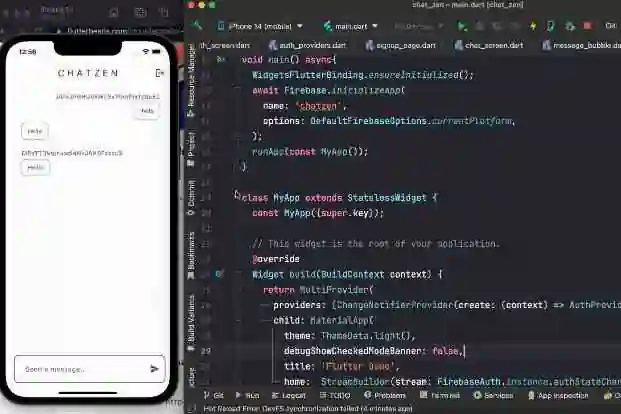dart-cheat-sheet
MAIN FUNCTION
void main() {
print('Hello, World!');
}
VARIABLES
// Variables can be declared using the var or type name syntax var age = 25; // inferred int created with var int count = 0; // explicit int declaration double pi = 3.14; // double num value = 42; // generic numeric type String name = 'Alice'; // single quotes String message = "Hello, $name!"; // double quotes with string interpolation bool isRaining = true; // booleans are declared using the bool keyword dynamic dynamicVar = 'hello'; // dynamic type can hold any value and its type determined at runtime final companyName = 'Acme Inc.'; // final keyword creates a variable that can be set only once const PI = 3.14159; // const keyword creates a compile-time constant
OPERATORS
// Arithmetic operators var sum = 10 + 20; // addition var difference = 40 - 30; // subtraction var product = 2 * 5; // multiplication var quotient = 15 / 3; // division var remainder = 20 % 3; // modulus // Comparison operators var isEqual = (5 == 5); // equality var notEqual = (5 != 6); // inequality var greaterThan = (5 > 3); // greater than var lessThan = (5 < 7); // less than var greaterOrEqual = (5 >= 5); // greater than or equal to var lessOrEqual = (5 <= 5); // less than or equal to // Logical operators var and = true && false; // logical and var or = true || false; // logical or var not = !true; // logical not // Assignment operators var x = 10; // simple assignment x += 5; // addition assignment (same as x = x + 5) x -= 2; // subtraction assignment (same as x = x - 2) x *= 3; // multiplication assignment (same as x = x * 3) x /= 2; // division assignment (same as x = x / 2) x %= 4; // modulus assignment (same as x = x % 4) // Conditional operator var isEven = (x % 2 == 0) ? true : false; // if-else shorthand
COMMENTS
// Single-line comments start with //
// This is a single-line comment
// Multi-line comments start with /* and end with */
/*
This is a multi-line comment
It can span multiple lines
*/
// Documentation comments are used to generate documentation for libraries, classes, functions, and variables
/// This is a documentation comment for a class.
/// It should describe what the class does and its properties and methods.
class MyClass {
int myProperty;
/// This is a documentation comment for a method.
/// It should describe what the method does and its parameters.
void myMethod(int param) {
// method code here
}
}
METADATA
// Metadata provides additional information about the code to tools and other programs
// Metadata provides additional information about the code to tools and other programs
// Metadata can be added to classes, methods, variables, and parameters using the @ symbol
// Common metadata includes:
// - @deprecated: indicates that a method or variable is no longer recommended for use
// - @override: indicates that a method is intended to override a method from a superclass or interface
// - @immutable: indicates that a class or property is read-only
// - @proxy: indicates that a class should be treated as a dynamic proxy
@deprecated
void myDeprecatedFunction() {
// deprecated function code here
}
class MyClass {
@override
void myMethod() {
// method code here
}
}
@immutable
class MyImmutableClass {
final int myProperty;
const MyImmutableClass(this.myProperty);
}
@proxy
class MyDynamicClass {
// proxy code here
}
LIBRARIES & IMPORTS
// Dart code is organized into libraries, which are collections of related code // Libraries are defined using the 'library' keyword, followed by the name of the library library my_library; // Code from other libraries can be accessed using the 'import' keyword import 'dart:math'; // import a core Dart library import 'package:flutter/material.dart'; // import a package from pub.dev // The 'as' keyword can be used to give an imported library a different name import 'package:flutter/cupertino.dart' as cupertino; // The 'show' and 'hide' keywords can be used to selectively import or hide parts of a library import 'package:my_package/my_module.dart' show myFunction; import 'package:my_package/my_module.dart' hide myPrivateFunction; // Code can also be exported from a library using the 'export' keyword export 'my_other_library.dart'; // Libraries can have a part directive to include source code from other files part 'my_file.dart';
TYPES
- built-in types
// Dart has built-in types for numbers, strings, and booleans
// Numbers can be declared as integers or doubles
int age = 42; // integer
double pi = 3.14; // double
// Strings can be declared using single or double quotes
String name = 'Alice'; // single quotes
String message = "Hello, $name!"; // double quotes with string interpolation
// Booleans are declared using the 'bool' keyword
bool isRaining = true;
// Methods for numbers:
age.toString(); // convert to string
pi.round(); // round to nearest integer
pi.floor(); // round down to integer
pi.ceil(); // round up to integer
// Methods for strings:
name.length; // get length
name.toUpperCase(); // convert to uppercase
message.contains('Alice'); // check if contains substring
message.replaceAll('Alice', 'Bob'); // replace substring
// Methods for booleans:
isRaining.toString(); // convert to string
!isRaining; // logical NOT
isRaining && isCold; // logical AND
isRaining || isSunny; // logical OR
- collections
// Dart has built-in types for lists, sets, and maps
// Lists can be declared using square brackets
List<int> numbers = [1, 2, 3, 4, 5];
// Sets can be declared using curly braces
Set<String> fruits = {'apple', 'banana', 'cherry'};
// Maps can be declared using curly braces with key-value pairs
Map<String, int> ages = {'Alice': 42, 'Bob': 37};
// Methods for lists:
numbers.length; // get length
numbers[2]; // access element at index
numbers.indexOf(3); // find index of element
numbers.add(6); // add element to end
numbers.remove(4); // remove element
numbers.forEach((number) => print(number)); // iterate over elements
// Methods for sets:
fruits.length; // get length
fruits.contains('banana'); // check if contains element
fruits.add('date'); // add element
fruits.remove('apple'); // remove element
fruits.forEach((fruit) => print(fruit)); // iterate over elements
// Methods for maps:
ages.length; // get length
ages['Alice']; // access value with key
ages.containsKey('Charlie'); // check if contains key
ages.putIfAbsent('Charlie', () => 30); // add key-value pair if absent
ages.remove('Bob'); // remove key-value pair
ages.forEach((key, value) => print('$key is $value years old')); // iterate over key-value pairs
- operators
// Dart has operators and control flow statements for working with collections
// Spread operator
var numbers = [1, 2, 3];
var moreNumbers = [0, ...numbers]; // spread operator inserts contents of numbers into moreNumbers
// For loops
for (var i = 0; i < numbers.length; i++) {
print(numbers[i]); // prints each element in numbers
}
// For-in loops
for (var number in numbers) {
print(number); // prints each element in numbers
}
// forEach method
numbers.forEach((number) => print(number)); // prints each element in numbers using a lambda function
// Map method
var doubledNumbers = numbers.map((number) => number * 2); // creates a new list with each element in numbers multiplied by 2
// Where method
var evenNumbers = numbers.where((number) => number % 2 == 0); // creates a new list with only the even elements in numbers
// Reduce method
var sum = numbers.reduce((value, element) => value + element); // computes the sum of all elements in numbers
// Conditional expressions
var age = 21;
var isLegal = age >= 18 ? 'Legal' : 'Illegal'; // ternary operator - sets isLegal to 'Legal' if age is greater than or equal to 18, and 'Illegal' otherwise
- generics
// Dart supports generics for creating reusable code
// Generic classes
class Box<T> {
T item;
Box(this.item);
T getItem() => item;
}
// Generic methods
T getFirst<T>(List<T> items) => items[0];
// Usage examples
var intBox = Box<int>(10); // creates a Box that can hold integers
var stringBox = Box<String>('hello'); // creates a Box that can hold strings
var numbers = [1, 2, 3];
var firstNumber = getFirst(numbers); // gets the first number in the list
- typedef
// Dart supports typedefs for defining function types
// Defining a typedef for a function type
typedef bool Filter(int number);
// Example of a function that takes a function type as a parameter
List<int> filterList(List<int> list, Filter filter) {
return list.where((number) => filter(number)).toList();
}
// Usage examples
bool isEven(int number) => number % 2 == 0;
bool isOdd(int number) => number % 2 == 1;
var numbers = [1, 2, 3, 4, 5];
var evenNumbers = filterList(numbers, isEven); // filters even numbers from the list
var oddNumbers = filterList(numbers, isOdd); // filters odd numbers from the list
CONTROL FLOW
- if-else Statements
// The if-else statement is used to execute code based on a condition
if (condition) {
// code to execute if the condition is true
} else {
// code to execute if the condition is false
}
- for loops
// The for loop is used to execute code repeatedly for a specific number of times
for (var i = 0; i < 10; i++) {
// code to execute on each iteration
}
- while loops
// The while loop is used to execute code repeatedly while a condition is true
while (condition) {
// code to execute while the condition is true
}
- do-while loops
// The do-while loop is used to execute code repeatedly at least once, and then as long as a condition is true
do {
// code to execute at least once
} while (condition);
- switch statements
// The switch statement is used to execute different code blocks based on different conditions
switch (variable) {
case value1:
// code to execute if variable equals value1
break;
case value2:
// code to execute if variable equals value2
break;
default:
// code to execute if variable does not equal any of the cases
break;
}
ERROR HANDLING
// Dart provides several ways to handle errors and exceptions
// Using try-catch blocks to handle exceptions
try {
var result = 42 ~/ 0; // throws an IntegerDivisionByZeroException
} catch (e) {
print("An exception occurred: $e"); // prints "An exception occurred: IntegerDivisionByZeroException"
}
// Using on clauses to handle specific exceptions
try {
var result = 42 ~/ 0; // throws an IntegerDivisionByZeroException
} on IntegerDivisionByZeroException {
print("Cannot divide by zero");
}
// Using finally clauses to execute code after try-catch blocks
try {
var result = 42 ~/ 0; // throws an IntegerDivisionByZeroException
} catch (e) {
print("An exception occurred: $e");
} finally {
print("This code always runs");
}
// Using rethrow to propagate an exception to the calling function
void riskyFunction() {
try {
var result = 42 ~/ 0; // throws an IntegerDivisionByZeroException
} catch (e) {
// rethrows the exception to the calling function
rethrow;
}
}
// Using assert statements to check for errors during development
void printNumber(int number) {
assert(number >= 0, "The number must be greater than or equal to zero");
print(number);
}
CLASSES & OBJECTS
// Dart is an object-oriented language, and classes are a fundamental building block
// Defining a class
class Person {
String name;
int age;
// A constructor with named parameters
Person({required this.name, required this.age});
// A named constructor
Person.fromJson(Map<String, dynamic> json) {
name = json['name'];
age = json['age'];
}
// A method that returns a string
String greet() {
return "Hello, my name is $name and I am $age years old";
}
}
// Inheriting from a class
class Employee extends Person {
String department;
// A constructor that calls the super constructor
Employee({required String name, required int age, required this.department})
: super(name: name, age: age);
// Overriding a method from the parent class
@override
String greet() {
return "Hello, my name is $name, I am $age years old, and I work in $department";
}
}
// Creating objects from classes
var person = Person(name: "Alice", age: 25);
var employee = Employee(name: "Bob", age: 30, department: "Sales");
// Calling methods on objects
print(person.greet()); // prints "Hello, my name is Alice and I am 25 years old"
print(employee.greet()); // prints "Hello, my name is Bob, I am 30 years old, and I work in Sales"
EXTENSION
// Define a class to be extended
class Person {
String name;
int age;
Person({required this.name, required this.age});
String greet() {
return "Hello, my name is $name and I am $age years old";
}
}
// Define an extension to add a new method to Person
extension on Person {
String introduce(String city) {
return "Hi, my name is $name and I am from $city";
}
}
void main() {
var person = Person(name: "Alice", age: 25);
print(person.introduce("New York")); // prints "Hi, my name is Alice and I am from New York"
}
ENUM
// An enum is a special kind of class used to represent a fixed number of values
enum Flavor {
vanilla,
chocolate,
strawberry,
mint,
}
// Enums can have properties and methods just like classes
extension FlavorExtensions on Flavor {
String get name {
return this.toString().split('.').last;
}
bool get isSweet {
switch (this) {
case Flavor.vanilla:
case Flavor.chocolate:
return true;
case Flavor.strawberry:
case Flavor.mint:
return false;
}
}
}
// Enums can be used like any other type in Dart
void printFlavorInfo(Flavor flavor) {
print("The flavor is ${flavor.name}");
print("Is it sweet? ${flavor.isSweet}");
}
// Example usage
void main() {
var myFlavor = Flavor.chocolate;
printFlavorInfo(myFlavor);
}
MIXIN
// A mixin is a way to reuse a class's code in multiple class hierarchies
// Defining a mixin
mixin Dancer {
void dance() {
print("Dancing...");
}
}
// Defining a class that uses the mixin
class Person with Dancer {
String name;
int age;
// A constructor with named parameters
Person({required this.name, required this.age});
// A method that returns a string
String greet() {
return "Hello, my name is $name and I am $age years old";
}
}
// Creating an object from the class
var person = Person(name: "Alice", age: 25);
// Calling a method on the object that was defined in the mixin
person.dance(); // prints "Dancing..."
CALLABLE CLASSES
// A callable class is one that can be invoked as a function
class Greeting {
String message;
// The constructor sets the message property
Greeting(this.message);
// The call() method allows instances of this class to be called as functions
String call(String name) {
return "$message, $name!";
}
}
// Example usage
void main() {
var hello = Greeting("Hello");
var goodbye = Greeting("Goodbye");
// Invoke the objects as functions
print(hello("Alice")); // prints "Hello, Alice!"
print(goodbye("Bob")); // prints "Goodbye, Bob!"
}
NULL SAFETY
void main() {
// Declaring nullable variables with the "?" operator
String? name;
int? age;
// Attempting to assign null to non-nullable variables causes an error
// String name;
// int age;
// Using the "!" operator to assert that a nullable variable is not null
name = "Alice";
age = 25;
print("Hello, my name is ${name!} and I am ${age!} years old");
// Using the "?? " operator to provide a default value for a nullable variable
String? jobTitle;
String message = "Hello";
message += jobTitle ?? "there";
print(message);
// Using the "late" keyword to indicate that a non-nullable variable will be assigned later
late String favoriteColor;
favoriteColor = "blue";
print("My favorite color is $favoriteColor");
// Using the "required" keyword in constructors to indicate non-nullability
final person = Person(name: "Bob", age: 30);
print("Hello, my name is ${person.name} and I am ${person.age} years old");
}
class Person {
final String name;
final int age;
Person({required this.name, required this.age});
}
ASYNCHRONOUS PROGRAMMING
- future : object that represents a value that may not be available yet.
void main() {
// Creating a Future object that resolves to a value after a delay
Future<String> delayedHello(int seconds) {
return Future.delayed(Duration(seconds: seconds), () => "Hello");
}
// Using a Future to execute code asynchronously
print("Before the Future");
delayedHello(2).then((value) => print(value));
print("After the Future");
}
// prints :
// Before the future
// After the future
// Hello, world!
- async & await : makes working with
futuremore convenient.
void main() async {
// Using the "async" keyword to mark a function as asynchronous
Future<String> delayedHello(int seconds) {
return Future.delayed(Duration(seconds: seconds), () => "Hello");
}
// Using "await" to wait for a Future to complete before continuing execution
print("Before the Future");
String value = await delayedHello(2);
print(value);
print("After the Future");
}
// prints :
// Before the future
// After the future
// Hello, world!
- the
asynckeyword is used to mark themainfunction as an asynchronous function, and theawaitkeyword is used to pause the execution of the function until thedelayedHello()Future has completed. - This allows the code to be written in a more synchronous style, where each line of code is executed one after the other, without blocking the event loop.














